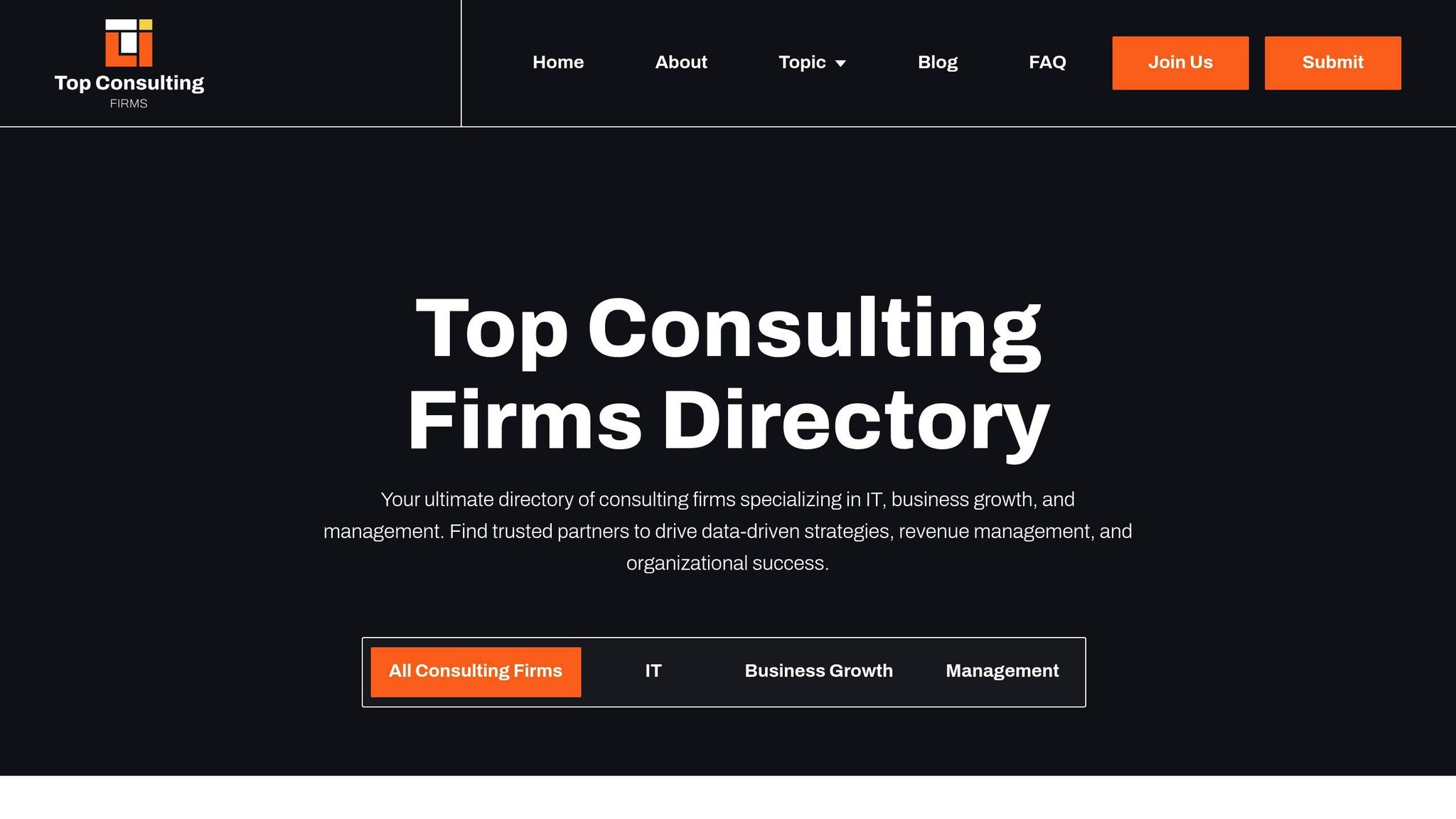Custom integration frameworks are becoming essential for U.S. businesses to connect software, automate workflows, and ensure data consistency. With the rise of remote work and digital-first strategies, companies need tailored solutions to meet specific needs, improve efficiency, and comply with regulations like SOX and HIPAA. Key trends shaping this space include:
- AI and Machine Learning: Automating tasks like data mapping, error detection, and predictive maintenance for faster, smarter integrations.
- Low-Code/No-Code Platforms: Enabling non-technical users to build integrations using drag-and-drop tools, addressing IT talent shortages.
- API-First and Microservices: Offering modular, scalable solutions for seamless system connections and hybrid cloud setups.
- Remote Team Solutions: Cloud-native and mobile-friendly tools that support real-time collaboration and secure data access for distributed teams.
Businesses must weigh the cost, scalability, and ROI of custom vs. off-the-shelf tools. While ready-made solutions offer faster deployment, custom frameworks align better with unique requirements and long-term growth. Consulting experts can help navigate these decisions, ensuring compliance and streamlining implementation.
A Brief Overview of LLM Agent Frameworks
New Technologies Changing Custom Integration Frameworks
Advancements in technology are reshaping integration frameworks, making data exchange smarter, more accessible, and adaptable to the demands of today’s fast-paced digital world. Let’s explore how AI, low-code platforms, and API-first designs are driving this transformation.
AI and Machine Learning in Integration Frameworks
Artificial intelligence (AI) and machine learning (ML) are redefining integration frameworks by going beyond basic data transfer to deliver intelligent automation that learns and improves with use. These tools are elevating key aspects of integration, such as data mapping, error detection, and predictive maintenance.
Take data mapping, for example. What once required weeks of manual effort can now be automated by AI, which not only speeds up the process but also improves accuracy over time as it learns from repeated tasks.
Machine learning also plays a critical role in detecting anomalies. It monitors data quality, transfer rates, and connection patterns in real time, allowing it to identify irregularities before they cause problems. For instance, if an unusual data flow is detected, the system can trigger backups or alert administrators, preventing minor issues from turning into major disruptions.
Predictive maintenance is another game-changer. By analyzing historical data and usage trends, AI can forecast potential connection failures or performance slowdowns. This enables businesses to schedule maintenance at optimal times, reducing downtime and ensuring smoother operations.
Overall, AI-driven frameworks cut down on maintenance costs and accelerate deployment, offering businesses a smarter and more efficient way to manage integrations.
Growth of Low-Code/No-Code Platforms
Low-code and no-code platforms are making integration development more accessible, empowering non-technical users to build and manage integrations on their own. This shift is particularly impactful for U.S. businesses, which often face IT talent shortages and need quick digital solutions.
These platforms replace traditional coding with drag-and-drop interfaces, enabling business users like analysts and department managers to create integrations without waiting on IT teams. This independence not only speeds up the process but also makes it easier to understand and adjust data flows as business needs evolve.
A key feature of these platforms is their pre-built connectors, which simplify integration with popular applications such as Salesforce, Microsoft Office 365, and QuickBooks. These connectors handle complex tasks like API authentication and error management, allowing users to focus on their goals without getting bogged down in technical details.
Security remains a priority, with built-in governance tools that let IT teams enforce policies, review connections, and monitor integrations from a centralized dashboard. This ensures that while business users gain autonomy, the organization’s security standards are not compromised.
By using low-code/no-code platforms, businesses can complete simple integrations much faster than traditional methods, helping them stay agile and responsive to changing demands.
API-First and Microservices Architecture Trends
While low-code tools make integration more accessible, API-first design and microservices architecture are enhancing scalability and efficiency in more advanced ways.
API-first design prioritizes APIs as the main interface for system interactions, ensuring they are standardized and well-documented. This approach makes integrations more modular and easier to maintain. Meanwhile, microservices break large, monolithic applications into smaller, independent services that can be scaled or updated individually.
Tools like Docker and Kubernetes simplify the deployment of these microservices, ensuring consistency across different environments. Additionally, event-driven architecture is becoming more popular, allowing systems to respond to real-time events rather than relying on constant polling. This reduces system load, improves response times, and supports more advanced automation workflows.
For U.S. businesses, the modularity and scalability of API-first and microservices approaches are especially appealing. Companies can start with simple integrations and gradually add complexity as needed, avoiding the need for a complete overhaul of their systems. This incremental approach keeps costs under control while allowing businesses to adapt to new requirements quickly.
These trends also align well with hybrid cloud strategies, which are increasingly common among U.S. organizations. APIs act as a bridge between on-premises systems and cloud applications, enabling seamless integration. This flexibility allows businesses to balance security, cost, and performance while building scalable, hybrid environments that support their growth and operational needs.
Integration Frameworks for Remote Teams
The rise of remote and hybrid work models has reshaped how businesses approach integration frameworks. With teams now operating from various locations, the need for systems that ensure data security while supporting real-time collaboration has taken center stage. This shift has driven the development of cloud-based and mobile-friendly solutions tailored for remote work environments.
Remote work has outgrown traditional office-based integration models. Employees spread across time zones require instant, synchronized access to data, whether they’re at home, on the road, or in a coworking space. As a result, businesses are turning to cloud-native platforms and mobile-optimized tools that work seamlessly across devices and locations.
Mobile-First and Cloud-Native Integration Solutions
As remote workers increasingly rely on smartphones and tablets for business tasks, mobile-first design has become a necessity. Today’s integration frameworks deliver responsive interfaces that function just as effectively on a smartphone screen as they do on a desktop monitor. This ensures that, for example, sales teams can pull up customer data during client meetings, and managers can approve workflows from wherever they are.
Cloud-native architecture has become the backbone of these solutions. Unlike traditional systems that rely on VPNs and complex security setups, cloud-native platforms provide direct, secure access via standard internet connections. This eliminates delays and reduces IT burdens.
Real-time synchronization is another must-have. For instance, if a customer service rep in Miami updates a support ticket, the accounting team in Seattle should see the changes immediately. Modern platforms achieve this through event-driven architectures, which push updates instantly rather than relying on scheduled batch processes.
Technologies like Docker have enabled container-based deployments, ensuring consistent environments for distributed teams. Whether developers are working from a corporate office or a home workspace, they can deploy identical setups, avoiding the discrepancies that previously hindered remote collaboration.
Edge computing has also become a game-changer. By processing data locally, it reduces latency and improves performance - especially for field teams who need quick access to inventory or customer databases in areas with spotty connectivity.
Security and Compliance for U.S. Regulations
Remote work has introduced new challenges in maintaining security and meeting U.S. regulatory standards. Integration frameworks now incorporate zero-trust models, verifying every connection and user to protect sensitive data.
For healthcare organizations, HIPAA compliance has become increasingly complex with remote teams. Integration platforms now include encryption for data in transit and at rest, detailed audit logging, and role-based access controls that dynamically adjust based on user needs.
SOC 2 Type II compliance has driven the adoption of advanced monitoring and logging features. These systems track every instance of data access, modification, and transfer, creating comprehensive audit trails that meet regulatory demands while supporting remote work flexibility.
Multi-factor authentication has evolved as well. Beyond traditional text codes, platforms now use biometrics, hardware keys, and adaptive controls that respond to user behavior for added security.
Data residency requirements have grown more intricate with distributed teams. Many integration frameworks now offer geographic controls to ensure sensitive information stays within designated regions, even when accessed remotely. This is critical for businesses navigating state-specific laws or international data transfer restrictions.
To support secure remote access, integration platforms now feature built-in VPN capabilities, encrypted communication channels, and automatic security updates - eliminating the need for IT teams to manually intervene at each remote location.
As state-level privacy laws continue to emerge, integration frameworks are adapting with configurable compliance modules. These tools allow businesses to adjust to new regulations without overhauling their entire system, making it easier to stay compliant in a constantly shifting legal landscape.
sbb-itb-97f6a47
Comparison of Top Integration Frameworks
As businesses in the U.S. navigate digital transformation, choosing the right integration framework becomes a critical decision. Companies must weigh factors like cost, scalability, and return on investment (ROI) to determine whether custom solutions or ready-made tools best suit their needs. Each approach has its strengths and trade-offs, so understanding how they compare is essential.
Custom Solutions vs. Ready-Made Tools
When it comes to cost, the initial investment often drives decision-making. Ready-made tools typically require up to 50% less upfront cost compared to custom development, making them appealing for businesses operating on tighter budgets. However, the custom software development market - valued at $29.29 billion in 2022 - is growing at a rate of 22.4% annually, reflecting the increasing demand for tailored solutions.
One major downside of off-the-shelf tools is their underutilization. Studies show that U.S. companies only use 10–15% of the features available in pre-built platforms, leaving a staggering 85–90% unused. In contrast, custom solutions are designed with specific business needs in mind, ensuring that every feature serves a purpose and adds value.
Scalability is another key consideration. As businesses expand, generic tools often fall short, with 70% of companies reporting challenges scaling these solutions. Custom systems, on the other hand, are 40% more adaptable to evolving needs, leading to 70% better workflow alignment and a 25% boost in productivity. This adaptability makes custom frameworks a strong choice for businesses anticipating growth.
Integration capabilities also set custom solutions apart. They can seamlessly connect with legacy systems and proprietary databases, which is particularly advantageous for established businesses with significant technology investments.
For organizations seeking immediate results, ready-made tools are often the go-to choice. These solutions can cut project timelines by an average of 30%, and 78% of businesses opt for them due to their affordability and ease of deployment. However, this speed often comes at the cost of long-term flexibility and efficiency.
ROI is a critical factor in the decision-making process. While ready-made tools offer lower upfront costs, custom solutions deliver impressive financial returns. Businesses that invest in custom development have reported ROIs ranging from 200% to 400% over three years. These solutions can also improve productivity by up to 35% and reduce operational costs by 15–30%.
That said, both approaches come with risks. Ready-made solutions often lead to vendor dependency, with 30% of businesses expressing dissatisfaction with vendor support. On the other hand, custom solutions can face budget overruns, with hidden costs driving expenses up by as much as 40%.
Regulatory compliance is another area where custom solutions shine. Industries like healthcare, finance, and government contracting often require strict adherence to regulations that generic platforms may struggle to meet. Custom frameworks can be built to include these specific requirements from the outset, reducing compliance risks and simplifying audits.
Ultimately, the choice between custom and ready-made solutions depends on your business’s unique needs. Ready-made tools are ideal for quick deployment and standard integration scenarios. In contrast, custom development is better suited for companies needing specialized features, preparing for significant growth, or operating in heavily regulated industries. These considerations highlight the importance of consulting with experts to refine your integration strategy.
Using Consulting Expertise for Better Integration
As custom integration frameworks continue to evolve, expert consulting has become a critical asset for U.S. businesses aiming to streamline operations and boost returns. With the growing complexity of technologies like AI-driven automation and cloud-native architectures, consulting partners play a key role in navigating technical decisions and ensuring successful implementation. Yet, many businesses underestimate the strategic value these experts bring to the table.
Why Expert Consulting Matters
Modern integration frameworks are intricate, often requiring specialized knowledge beyond the scope of internal IT teams. Consulting firms with deep experience in digital transformation help businesses sidestep common mistakes that could lead to delays or inflated costs.
Consultants bring value by identifying risks early, aligning technology choices with long-term goals, and ensuring compliance with industry standards. Their ability to foresee potential roadblocks and guide decision-making helps prevent setbacks and keeps projects on track.
One standout benefit is knowledge transfer. A strong consulting partner doesn’t just implement solutions - they empower your team by training them in best practices and optimization techniques. This reduces reliance on external help and equips your organization to adapt as your needs evolve.
By bridging the gap between technology and business objectives, expert consulting ensures a smoother path to achieving your integration goals.
Finding the Right Partner with the Top Consulting Firms Directory

Once you understand the benefits of expert consulting, the next challenge is finding the right partner. This is where the Top Consulting Firms Directory becomes invaluable. It’s a resource designed to connect businesses with pre-vetted consulting firms specializing in IT strategy, digital transformation, and custom integration.
The directory features firms with proven expertise in areas like cloud services, data analytics, cybersecurity, and software development. These firms don’t just understand the technical challenges of integration - they also grasp the business implications, helping you make informed decisions that align with your long-term vision.
For businesses planning growth, the directory includes firms skilled in scaling technology infrastructures. If your company is navigating mergers or acquisitions, you’ll find specialists experienced in integrating diverse systems during transitions.
Additionally, many of these consulting partners offer strengths in risk management and financial advisory. They conduct thorough cost-benefit analyses and structure projects to minimize financial risks, ensuring your investment delivers the desired returns.
Using the directory saves time by connecting you directly with consulting firms that match your project needs. Instead of sifting through countless options, you can focus on evaluating compatibility and cultural fit, knowing the firms listed are already vetted for their qualifications.
With its emphasis on IT infrastructure and software development, the directory is a go-to resource for finding partners who understand modern integration challenges. These experts stay ahead of trends like low-code platforms, AI-driven automation, and cloud-native solutions, bringing valuable insights to your projects.
Conclusion and Key Points
As businesses navigate the rapidly evolving digital landscape, custom integration frameworks have emerged as vital tools for staying connected and competitive. By incorporating AI automation, cloud-native architectures, and low-code platforms, these frameworks are transforming how U.S. companies streamline their operations and adapt to modern demands.
AI and machine learning are reshaping integration processes by automating complex tasks like data mapping and reducing time spent on manual configurations. This leads to greater efficiency and smoother operations. At the same time, microservices architecture and API-first approaches offer businesses the flexibility to build scalable and adaptable solutions that grow alongside their needs.
Security and compliance remain critical, especially with the increasing focus on U.S. data protection and privacy regulations. Modern frameworks must strike a balance between innovation and robust security measures, ensuring sensitive information stays protected while meeting regulatory requirements.
Choosing the right integration solution hinges on factors like business goals, budget, and operational complexity. Off-the-shelf platforms may provide faster deployment, but custom frameworks offer the tailored flexibility needed to address unique processes and challenges.
Expert consulting plays a crucial role in bridging advanced technology and business strategy. With the complexities of AI-driven automation, cloud solutions, and compliance demands, many organizations turn to external specialists for guidance. Resources like the Top Consulting Firms Directory connect businesses with professionals who understand both the technical details and broader strategic implications of integration projects.
FAQs
How do AI and machine learning improve the performance of custom integration frameworks?
AI and machine learning play a major role in improving custom integration frameworks by automating tasks like data mapping, transformation, and error detection. These technologies cut down on manual effort, reduce errors, and accelerate integration processes.
What’s more, AI-driven systems have the ability to learn and refine themselves over time. This leads to better data quality and greater accuracy, ensuring consistent and dependable outcomes. As a result, businesses can make quicker, well-informed decisions while streamlining their operations.
What advantages do low-code and no-code platforms offer businesses dealing with IT talent shortages?
Low-code and no-code platforms offer major benefits for businesses dealing with IT talent shortages. They speed up application development, boost productivity, and minimize the reliance on highly specialized developers. By simplifying coding tasks, these platforms allow even non-technical employees to build workflows and applications, effectively narrowing the skills gap.
This streamlined approach helps businesses adapt faster to market demands, cut development costs, and enable teams to create solutions without heavily depending on IT departments. As a result, low-code and no-code platforms have become an important resource for tackling IT challenges and staying competitive.
Why should businesses consider custom integration frameworks instead of off-the-shelf tools, and how can this impact ROI?
Businesses often opt for custom integration frameworks because they cater specifically to their operational requirements. These tailored solutions align with unique workflows, ensuring they seamlessly integrate with existing systems and processes. This personalized approach also allows businesses to adjust and expand their frameworks as they grow, offering a level of flexibility that off-the-shelf tools typically can't match.
From a return on investment (ROI) perspective, custom frameworks often prove their worth. Companies frequently report tangible benefits, such as streamlined operations, lower costs, and quicker rollouts for new projects. In many cases, businesses achieve a positive ROI within 12 to 24 months, with long-term savings and enhanced performance driving consistent growth.


